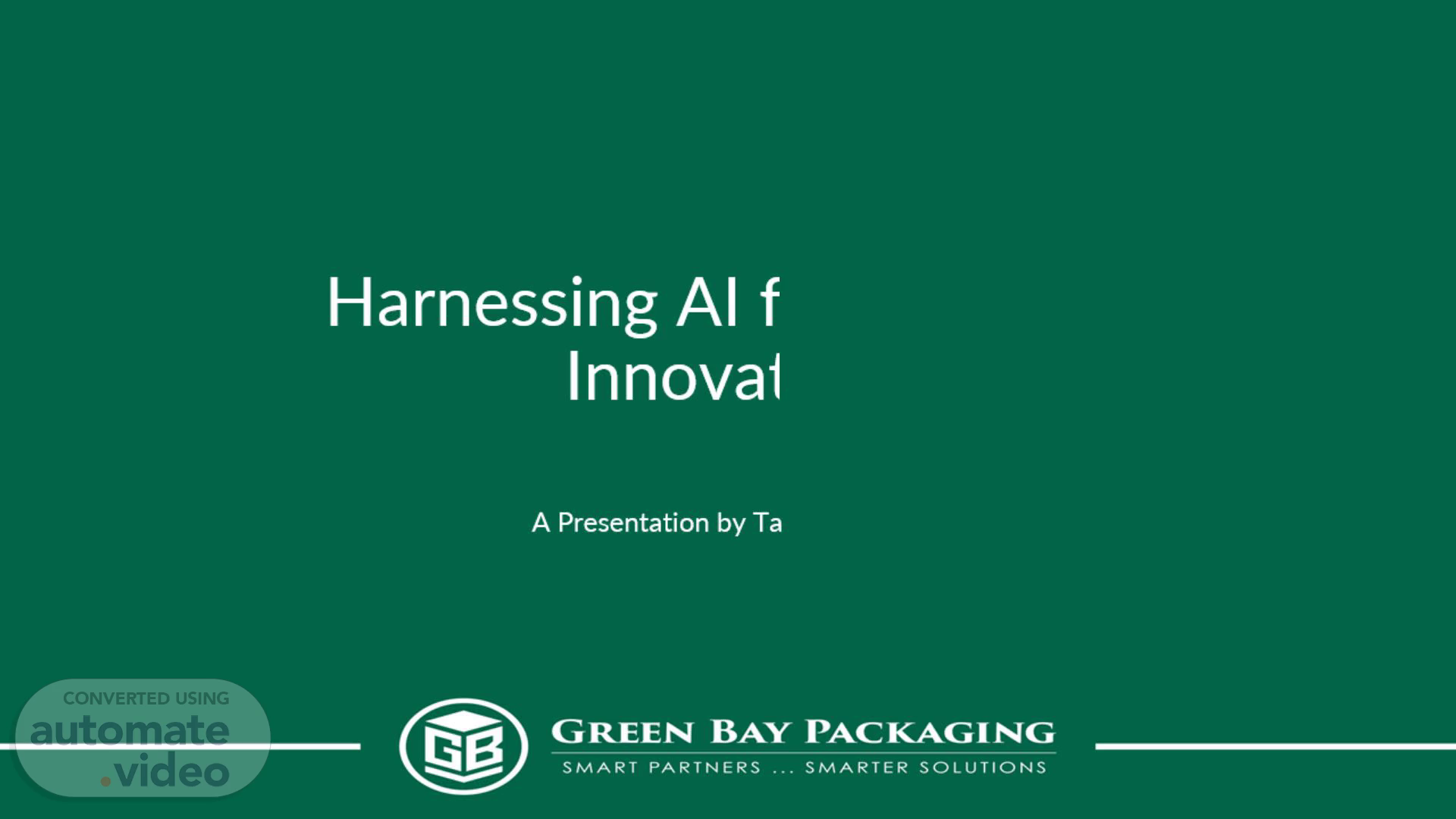Scene 1 (0s)
Harnessing AI for Business Innovation. A Presentation by Taylor Worley.
Scene 2 (7s)
About Me. Professional Background 14 years experience as a software developer 10 years in Healthcare at HSHS AI at HSHS Developed and implemented two Machine Learning algorithms still in use Septic Shock Detection Early identification of Septic Shock in patients No Call/No Show Scheduling optimization Other Experience Admin of a Facebook ML Sports Betting page Assisted in curating the COVID-19 dataset for NYU in 2020 Various AI Conferences Ai4 Epic UKG NEWDA Tech Summit 2024.
Scene 3 (28s)
Agenda. What AI actually looks like Challenges and Challenge Context Our current approach to AI AI vs Power BI/Analytics Use Cases Wrap up.
Scene 4 (38s)
"The easy part is making the model, The hard part is running (Operationalizing) the model." – Elaine Stephens, Head of Customer Engineering (Wisconsin), Google.
Scene 5 (52s)
Types of AI in Manufacturing. Machine Learning (ML) Predictive Maintenance Demand Forecasting Computer Vision Quality Control Worker Safety Natural Language Processing Expert Knowledge Gap Bridge Customer Support Robotics and Automation Cobots RPA Generative Documentation Knowledge Base Synthesis Software Development AIoT.
Scene 6 (1m 8s)
AI Challenges. Data Quality and Availability Lack of Skilled Talent Integration with Existing Systems High Costs and Uncertainty in ROI Ethical and Legal Concerns Change Management.
Scene 7 (1m 18s)
AI Challenges (according to AI). A graph of different colored squares Description automatically generated.
Scene 8 (1m 26s)
Intro to CPMAI Free Course - Cognilytica. Put another way in the CPMAI model… 1/5th is information gathering Half of an AI project is Data 1/3rd is Model development and implementation.
Scene 9 (1m 39s)
80% of A1 Projects are Data Engineering Percentage of Time Allocated to Machine Learning Project Tasks Source Cogn+yt.ca ML Operationalization ML Model Tumng ML Model Training ML Algorithm Dev. Data Augrnentation Data Labeling Data Identification Data Aggregation Data Cleanstng.
Scene 10 (1m 50s)
GBP’s (Pre)Approach to AI. A committee is needed to analyze business needs, data, and security Emphasis on data cleanliness and security (data debt is a concern) AI deployment involves pre-processing, fine-tuning, multiple iterations, and ongoing analysis and maintenance — not just enabling a license.
Scene 11 (2m 5s)
AI vs. PowerBI: Key Differences. PowerBI AI Data visualization and reporting tool Requires complex processes such as pre-processing, model training, and fine-tuning Reports historical and current data Uses historical and current data to predict Once its built and you know it’s right, it’s right Requires ongoing analysis and maintenance Analogies Map vs GPS Recipe vs Chef Medical Chart vs Doctor.
Scene 12 (2m 24s)
What is Copilot?. Copilot is Microsoft's AI assistant that integrates into MS apps (Word, Excel, etc.) Large Language Models (LLMs) are AI systems trained on massive datasets LLMs like Copilot and ChatGPT enhance productivity by generating human-like responses.
Scene 13 (2m 38s)
Microsoft Copilot Trained on Our Kiwi Documentation.
Scene 14 (2m 52s)
ChatGPT Trained on Our Alpha Documentation. Custom AI Assistant Developed a custom GPT model using OpenAI Trained on documentation for Alpha Benefits Provides quick and accurate information retrieval Enhances employee productivity Improves onboarding for new team members.
Scene 15 (3m 4s)
Quality Control with Computer Vision. Overview Implementing AI-powered computer vision to detect product defects Benefits Enhances product quality Reduces waste and rework Increases customer satisfaction.
Scene 16 (3m 15s)
Worker Safety using Computer Vision. Overview Utilizing AI to enhance workplace safety Benefits Prevents accidents and injuries Ensures compliance with safety regulations Promotes a culture of safety Worker Safety Animation.
Scene 17 (3m 26s)
Sales Demand Forecasting Demo. Introduction Leveraging AI to accurately forecast customer demand Benefits Optimizes inventory levels Reduces overstock and stockouts Improves supply chain efficiency.
Scene 18 (3m 36s)
Conclusion. Key Takeaways AI is a powerful tool that can and will transform various aspects of our business The insights are there, but we need to build an ecosystem Call to Action Identify areas where AI can be implemented Continuous learning about AI advancements “If you’re not starting to dabble now, you’re going to fall way behind.” – Matt Adamczyk, Principle Technical Program Manager, Microsoft Although many seem plug n play, immense time investment and human oversight is needed for quality systems Embrace both the benefits and challenges this new paradigm will bring.
Scene 19 (4m 1s)
Q&A Session.
Scene 20 (4m 7s)
Bonus Use Cases if we have time. Sensor Anomaly Detection Energy Consumption Optimization AI-Powered Inventory Management Real-Time Production Line Monitoring Predictive Maintenance Simplified Predictive Maintenance Dashboard Supply Chain Optimization Production Scheduling under Uncertainty.
